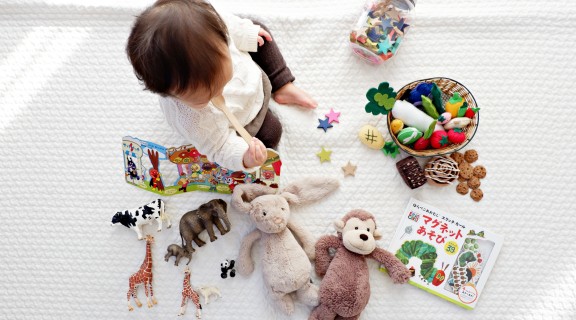
Loose parts, endless possibilities
28 October 2021 | State Library of Queensland
When we give a child a box, it’s a big empty invitation to make something! It’s amazing how quickly a box can become a garage or a castle, a cave or a shop. Your little one’s brain is busy turning their ideas into small world reality.
Loose parts, like our empty box, are materials that your child can tinker with, move, combine, redesign, line up, stack, take apart and put back together. Unlike ‘finished’ toys, loose parts are full of potential for creativity and language development. Take, for instance, a basket of wooden utensils, soft balls, blocks, smooth pebbles or sticks. It’s an open invitation for your child to experiment - “Does this block go here or here?”; problem solve - “How can I make this stack higher without it falling?”, and role play - “Beep, beep. I’m driving a bus!”
This type of play helps build your child’s word bank as they learn how things work in the world. You can play along too, voicing characters, asking questions and listening to your child. When you do this, you’re helping them learn even more words and how to use them!
You’ll be surprised just what you can find around your home to inspire loose parts play - wooden blocks, safe cooking utensils, shells, measuring cups, balls, keys, cardboard rolls, straws. And the best thing about loose parts play is there are no instructions or rules!
“All children are creative beings”
Here are some other ways to use low-cost, everyday items at home that will support conversations that are unique to your child and the way they see the world:
-
Turn boxes into short tunnels and play peek-a-boo play with your baby.
-
Take a nature walk to collect items like dry leaves, flowers, twigs and stones that can be used in play once you get home.
-
Stack stones in a sunny spot outside – the lizards will thank you!
-
Use scarves, ribbons or wraps during tummy time play.
-
Create a loose parts sensory bag with textured items – can you guess without peeking?
-
Put together a dress-up box with fabrics in different colours and textures – faux fur, felt scraps, old clothes, feathers, sheets and blankets – explore that way they feel.
-
Make sensory baskets with bottle caps, buttons and baubles for older children or put interesting items like feathers or bells in tightly sealed plastic containers for little ones to safely explore.
With a little practice, you’ll start seeing loose parts potential everywhere!
Comments
Your email address will not be published.
We welcome relevant, respectful comments.